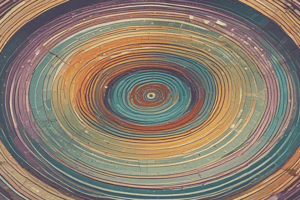Podcast
Questions and Answers
What are the two main players in the simple circular flow model?
What are the two main players in the simple circular flow model?
- Firms and the financial market
- Consumers and producers
- Households and firms (correct)
- Households and the government
Which of the following is considered a leakage in the circular flow model?
Which of the following is considered a leakage in the circular flow model?
- Government spending
- Investment
- Exports
- Savings (correct)
What is the outcome when injections are greater than leakages in the circular flow model?
What is the outcome when injections are greater than leakages in the circular flow model?
- The circular flow model collapses
- The circular flow model expands (correct)
- The circular flow model shrinks
- The circular flow model remains static
Which factor is NOT supplied by households in the resource market?
Which factor is NOT supplied by households in the resource market?
How does the circular flow model illustrate the relationship between income and spending?
How does the circular flow model illustrate the relationship between income and spending?
What role do firms play in the product market according to the circular flow model?
What role do firms play in the product market according to the circular flow model?
Which of the following is an injection into the circular flow model?
Which of the following is an injection into the circular flow model?
What does the business cycle illustrate regarding GDP?
What does the business cycle illustrate regarding GDP?
What characterizes the expansion phase of the business cycle?
What characterizes the expansion phase of the business cycle?
What signifies the transition from a contractionary phase to a recession?
What signifies the transition from a contractionary phase to a recession?
Which component is NOT included in the GDP calculation using the expenditure approach?
Which component is NOT included in the GDP calculation using the expenditure approach?
In the context of macroeconomics, what does a peak indicate?
In the context of macroeconomics, what does a peak indicate?
What is the primary distinction between nominal GDP and real GDP?
What is the primary distinction between nominal GDP and real GDP?
Which of the following methods is the most common for measuring GDP?
Which of the following methods is the most common for measuring GDP?
What happens during a contraction in the business cycle?
What happens during a contraction in the business cycle?
Which of the following is an example of a non-produced transaction that is not counted in GDP?
Which of the following is an example of a non-produced transaction that is not counted in GDP?
Which component of the GDP equation represents net exports?
Which component of the GDP equation represents net exports?
Flashcards
What is Macroeconomics?
What is Macroeconomics?
The study of how decisions by all consumers, producers, the government, and foreigners affect a country's overall economy.
What is the Circular Flow Model?
What is the Circular Flow Model?
A visual representation of how money flows through an economy, highlighting the interaction between households and firms.
What are Factors of Production?
What are Factors of Production?
Resources like land, labor, capital, and entrepreneurship that households provide to firms in exchange for payments.
What is the Resource Market?
What is the Resource Market?
Signup and view all the flashcards
What is the Product Market?
What is the Product Market?
Signup and view all the flashcards
What are Leakages?
What are Leakages?
Signup and view all the flashcards
What are Injections?
What are Injections?
Signup and view all the flashcards
What is The Business Cycle?
What is The Business Cycle?
Signup and view all the flashcards
Business Cycle
Business Cycle
Signup and view all the flashcards
Expansionary Phase
Expansionary Phase
Signup and view all the flashcards
Contractionary Phase
Contractionary Phase
Signup and view all the flashcards
Recession
Recession
Signup and view all the flashcards
Trough
Trough
Signup and view all the flashcards
Nominal GDP
Nominal GDP
Signup and view all the flashcards
Real GDP
Real GDP
Signup and view all the flashcards
GDP Deflator
GDP Deflator
Signup and view all the flashcards
Expenditure Approach to GDP
Expenditure Approach to GDP
Signup and view all the flashcards
Consumption (C)
Consumption (C)
Signup and view all the flashcards
Study Notes
Macroeconomics Overview
- Macroeconomics studies a country's entire economy, unlike microeconomics that focuses on individual markets.
- It analyzes decisions of consumers, producers, government, and foreign entities impacting a nation's economy.
Circular Flow Model
- Illustrates money flow within an economy, simplified to households and firms.
- In the resource market, households provide resources (land, labor, capital, entrepreneurship) to firms, receiving payments (rent, wages, interest, profit).
- In the product market, households spend income on goods and services from firms.
- Households are resource suppliers and product demanders, while firms are product suppliers and resource demanders.
- Output, income, and spending are equal within the economy.
- Complex models include leakages (savings, taxes, imports) and injections (investment, government spending, exports).
- Leakages exceeding injections cause a shrinking economy; the reverse leads to growth.
Business Cycle
- Shows short-term fluctuations in economic output around long-term growth trends.
- Expansions feature low unemployment, rising prices, and increasing output.
- Contractions exhibit rising unemployment, slowing or declining output.
- A contraction lasting at least six months is a recession.
- The economy aims to maintain relatively consistent growth close to its potential.
GDP Measurement
- Gross Domestic Product (GDP) measures a country's economic activity.
- GDP is calculated via income, output, and spending approaches (often using the expenditure method).
- Expenditure approach: GDP = C + I + G + Xn (Consumption + Investment + Government spending + Net exports).
- Intermediate goods are excluded to avoid double-counting.
- Only goods and services produced within a country are included.
- Illegal activities, non-produced transactions (like stocks/bonds), and transfer payments (e.g., social security) are not factored in.
- Homemade goods have no market value and aren't included.
Nominal vs. Real GDP
- Nominal GDP uses current prices, and real GDP adjusts for inflation.
- Real GDP provides a more accurate measure of economic growth compared to nominal values.
- A percentage change formula is used to calculate economic growth based on GDP changes.
- GDP deflator formula can get real GDP values by adjusting nominal values for inflation.
Studying That Suits You
Use AI to generate personalized quizzes and flashcards to suit your learning preferences.




